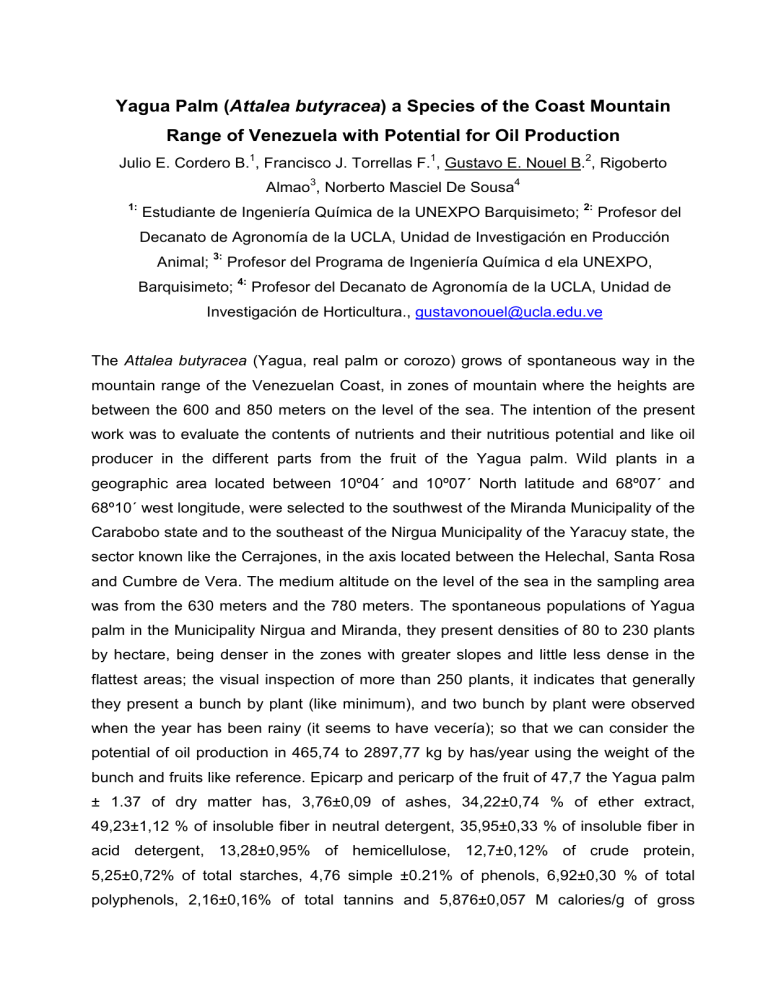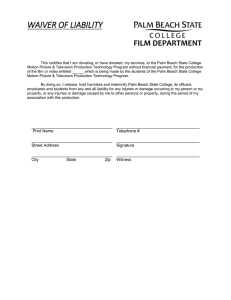
Yagua Palm (Attalea butyracea) a Species of the Coast Mountain Range of Venezuela with Potential for Oil Production Julio E. Cordero B.1, Francisco J. Torrellas F.1, Gustavo E. Nouel B.2, Rigoberto Almao3, Norberto Masciel De Sousa4 1: Estudiante de Ingeniería Química de la UNEXPO Barquisimeto; 2: Profesor del Decanato de Agronomía de la UCLA, Unidad de Investigación en Producción Animal; 3: Profesor del Programa de Ingeniería Química d ela UNEXPO, Barquisimeto; 4: Profesor del Decanato de Agronomía de la UCLA, Unidad de Investigación de Horticultura., gustavonouel@ucla.edu.ve The Attalea butyracea (Yagua, real palm or corozo) grows of spontaneous way in the mountain range of the Venezuelan Coast, in zones of mountain where the heights are between the 600 and 850 meters on the level of the sea. The intention of the present work was to evaluate the contents of nutrients and their nutritious potential and like oil producer in the different parts from the fruit of the Yagua palm. Wild plants in a geographic area located between 10º04´ and 10º07´ North latitude and 68º07´ and 68º10´ west longitude, were selected to the southwest of the Miranda Municipality of the Carabobo state and to the southeast of the Nirgua Municipality of the Yaracuy state, the sector known like the Cerrajones, in the axis located between the Helechal, Santa Rosa and Cumbre de Vera. The medium altitude on the level of the sea in the sampling area was from the 630 meters and the 780 meters. The spontaneous populations of Yagua palm in the Municipality Nirgua and Miranda, they present densities of 80 to 230 plants by hectare, being denser in the zones with greater slopes and little less dense in the flattest areas; the visual inspection of more than 250 plants, it indicates that generally they present a bunch by plant (like minimum), and two bunch by plant were observed when the year has been rainy (it seems to have vecería); so that we can consider the potential of oil production in 465,74 to 2897,77 kg by has/year using the weight of the bunch and fruits like reference. Epicarp and pericarp of the fruit of 47,7 the Yagua palm ± 1.37 of dry matter has, 3,76±0,09 of ashes, 34,22±0,74 % of ether extract, 49,23±1,12 % of insoluble fiber in neutral detergent, 35,95±0,33 % of insoluble fiber in acid detergent, 13,28±0,95% of hemicellulose, 12,7±0,12% of crude protein, 5,25±0,72% of total starches, 4,76 simple ±0.21% of phenols, 6,92±0,30 % of total polyphenols, 2,16±0,16% of total tannins and 5,876±0,057 M calories/g of gross energy. The oil of epicarp and mesocarp has a density of 0,84±0,001 g/milliliter (27,6ºC), pH of 4,72±0,27 (27,6ºC) and a gross energy of 9,304±0,005 M calories/g. The almond of the fruit of the Yagua palm has 96,09±0,77 of dry matter, 1,73±0,07 of ashes, 33,05±3,04 % of ether extract, 61,58±2,33 % of insoluble fiber in neutral detergent, 44,19±2,23 % of insoluble fiber in acid detergent, 17,39±1,89 % of hemicellulose, 7,97±0,32 % of crude protein, 7,33±1,75 % of total starches, 0,99±0,04 % of simple phenols, 1,46±0,01 % of total polyphenols total, 0,47±0,03 % of total tannins and 7,213±0,055 M calories/g of gross energy. The oil of almond of Yagua has a density of 0,85±0,0016 g/milliliter (27,6ºC), pH of 6,29±0,08 (27,6ºC) and a gross energy of 8,742±0,051 M calories/g. These characteristics make a plant with nutritious potential to be evaluated like oil source for animals or humans who would grow in conditions of tropical sub-humid forest.


